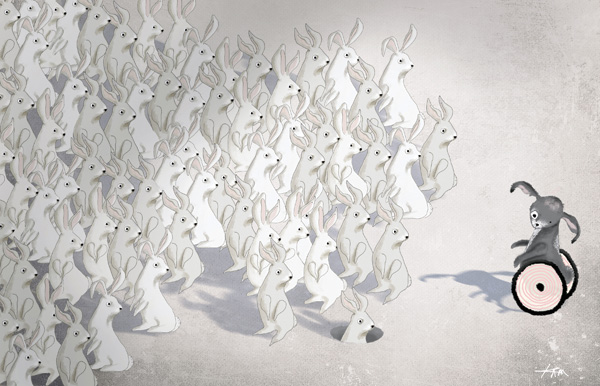story and illustration by KAM REDLAWSK
When I was young, I hated being different. Like most adolescent girls, struggling with identity and the awkwardness of puberty, I didn’t exactly exude confidence. I certainly never wanted to stand out, preferring instead to blend in with the crowd. Of course, the problem was that, while I aspired to be like my white classmates in my small-town Michigan school—especially the pretty, popular ones—my Asian face certainly didn’t help me blend in with them.
Little did I realize back then that being different would only extend into my adulthood and intensify times 100, as a result of my disability, a rare muscle-wasting disease. My condition has forced me not only to deal with the physical complications of accomplishing previously simple tasks, but also to truly learn about myself, know myself and accept my different-ness. I need to project a strong self-confidence, after all, in order to face a world that is often harsh toward people with disabilities.
There is no manual for this, but what helps me is that I don’t see myself the way those people see me. I obviously feel the disability and the daily struggle, but I don’t feel like I am “abnormal, defective or damaged goods”—the types of things I feel projected through many strangers’ stares and whispers when they see me in my wheelchair.
I do believe the way you hold yourself as a person is the way others will treat you. However, the negative perception associated with disability is still there. And, even as I try to guard myself against the stares, the comments, the pity, they aren’t totally lost on me, especially when I hear, “What’s wrong with you?” or “What happened to you?” from some random stranger who has spent mere seconds with me. Such questioning feels like bullets from a firing squad, wounding me with the inference that I’m broken, not a contribution to society, void of talents and value that go beyond my physical attributes.
My response depends on how I’m feeling that particular day. Sometimes, I’ll use the situation to enlighten and educate the ignorant stranger. I actually don’t mind talking about my disability at all. But on bad days, I can’t be bothered and may reply, “What do you mean?” or “Nothing. What’s wrong with you?” And on very bad days, when I may have just experienced a fall or another milestone in the progression of my disease, something like “What’s wrong with you?” may trigger tears. The insensitive inquisitor may not realize he or she has jolted me back to the reality that, yes, I truly am different. And not only that, in my case, that different-ness has given me a very difficult present and future.
Most of the time, people are well-intentioned, but when they encounter something or someone different, they might feel uncomfortable, maybe even fearful, and don’t quite know how to react. It’s like we have the knee-jerk reaction to embrace sameness and to fear what we consider “not normal.” But, you know what? Being different is good; being different does not equal not enough—and this goes for not only disabled individuals.
My husband often likes to point out that my entire life story—from my adoptee background, to my career path of car design major to toy designer to later an illustrator, writer and patient advocate with a rare, one-in-a-million disease (not to mention my red hair)—and who I am are anything but “normal.”
And, actually, that is one of the great things about this journey I am on. However difficult this condition is, stripping me of choices and the life I wanted for myself, sometimes bringing me to a crying mess because I can’t do the things I used to, I can still say that I love that I am unique. It has taught me so much, and I have never been as confident as I am today. Uncomfortable can be a good thing. In fact, I say, the more you can put yourself into uncomfortable situations, the better.
To those who ask, “What’s wrong with you?” I answer, “There is nothing wrong with me. I’m just fine.”
___
Kam Redlawsk’s column runs every other month. To read more from Kam, visit greengreengrass.typepad.com or her official Facebook page.
This story was published in the February/March 2015 issue of KoreAm. Subscribe today! To purchase a single issue copy of the February/March issue, click the “Buy Now” button below. (U.S. customers only. Expect delivery in 5-7 business days).
![]()










